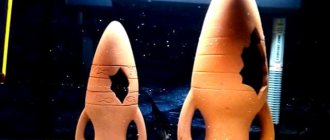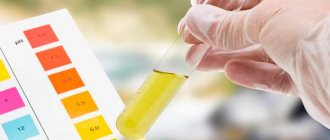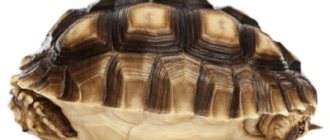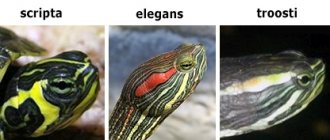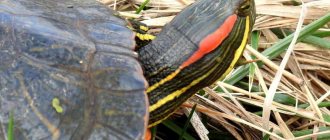Quickly navigate to the article
- 1 Ways to maintain temperature in an aquaterrarium
- 2 Water for aquarium
- 3 Cleanliness is a guarantee of health and longevity 3.1 Other interesting articles
This species of turtle belongs to the freshwater turtle family. In nature, they can be found in small lakes or ponds with marshy banks, in small swamps, as well as in river floodplains. For normal life they need fresh water. Without it, the turtle will not live more than two days. Water is of great importance for them, as it replaces the gym, dining room and bedroom. But this does not mean that she only needs water. For normal development, especially in an aquaterrarium, the turtle should be given at least ¼ of the land area.
Habitat of red-eared turtles
Trachemys scripta's habitat is primarily southeastern America and the adjacent region of Mexico: from southwestern Virginia through Florida, Alabama, Mississippi, Louisiana and Texas to Mexico. To the north, the habitat extends to the ends of Kentucky, Tennessee, Ohio, Indiana, Illinois and Iowa, and to the west to Kansas, Oklahoma and New Mexico.
Red-eared slider sizes
Trachemys scripta elegans predominates predominantly in the western and central parts of this range. Occupying the Mississippi Valley from Illinois through eastern New Mexico west to the Gulf of Mexico.
Trachemys scripta scripta is predominant in the eastern part of its previously described range, ranging from southeastern Virginia to northern Florida. It should be noted here that an intergradation zone of Ts elegans and Ts scripta is formed in Alabama.
Trachemys scripta troostii has the smallest range of occurrence and is found in the upper Cumberland and Tennessee rivers. From southeastern Kentucky and southwestern Virginia through Tennessee to northeastern Alabama.
Trachemys scripta occurs in a wide range of freshwater habitats including rivers, ditches, swamps, lakes and ponds. Quiet reservoirs with a soft bottom and an abundance of aquatic vegetation.
Design options
Terrariums can have different designs, each of which has its own special qualities.
Wooden structure
Most often, at home, these pets are kept in ordinary wooden boxes of appropriate sizes. This is a simple design that is easy to build and does not require special materials.
Wood and glass combination
Many breeders improve wooden structures by replacing one of the walls with frosted plexiglass
It is important not to forget about the ventilation holes
You will be interested to learn about the features of keeping a land turtle, snapping turtle, Central Asian land turtle, fringed turtle, swamp turtle, Chinese turtle, snapping turtle, red-eared turtle.
Plastic container
This is an inexpensive, but very comfortable house for the ward. Its main disadvantage is the difficulty of installing a lamp for heating a turtle
It is important that this item does not threaten her life and provides the necessary amount of heat and light
Did you know? All turtles are long-lived. In natural conditions they can live for more than a hundred years. For example, the oldest armored reptile in Europe is still considered to be a ward of the Galapagos Zoo named Harrient, who died in 2006. Then the animal turned 250 years old. But the most interesting thing is that on his life’s path he had the opportunity to meet Charles Darwin himself, who brought him to the European expanses
.
Floor pen
According to experts, this is not the best option for keeping a turtle. But at first, until the question of her permanent place of residence is resolved, you can fence off a corner for the ward right on the floor in the apartment.
The height of this fence should correspond to the size of the resident (we will talk about this in more detail later)
It is important that the floor is insulated, otherwise the reptile will get sick and die. You can't keep it on bare tiles.
Aquarium
Shelf in the sideboard
Not a bad option for an armored ward, but its arrangement requires a lot of effort on the part of the owner
It is important to ensure good mounting of the heating lamp, and this design must also be safe. Give preference to wide and high shelves so that the beast does not get burned
Important! A turtle terrarium must have small pebbles. If the animal shows a tendency to swallow pebbles, immediately replace the mound with larger stones.
Description of red-eared turtles and species
Red-eared slider photo
Red-eared turtles are born with a shell length of only 30 mm and have a very attractive bright color. In the first 1.5 years, the turtle reaches a size of 75 mm. After which the growth rate decreases and on average the growth is 10 – 15 mm per year. Individuals are characterized by the presence of distinct red or yellow-red spots on both sides of the head. The shell and skin are olive, olive-brown or green with yellow stripes. The shape of the shell is oval. Legs with large claws and membranes between the toes.
This species cannot be classified as ornamental, since the average size of the freshwater red-eared turtle is from 125 to 289 mm, however, there are records of individuals reaching a size of 350 mm. In the wild, the red-eared turtle lives for about 20 years; in captivity, it can even live up to 40 years.
Over time, the turtle's large size and lifespan embarrass buyers, who are unable to keep the turtles in captivity for long periods of time and release them into the wild.
Trachemys scripta elegans.
Red-eared slider photo
The length of the carapace of Trachemys scripta elegans reaches 280 mm. There is a wide red stripe on the head and narrow stripes on the chin. On each costal carapace there is a transverse yellow stripe. Plastron with a large spot on each scute.
Trachemys scripta scripta.
Red-eared slider photo
The length of the carapace of Trachemys scripta scripta reaches 270 mm. There is a yellow postorbital spot on the head, connected to a stripe on the neck. Each costal carapace has a yellow stripe. The plastron is yellow with spots on most of the front scutes.
Trachemys scripta troostii.
Red-eared slider photo
The length of the carapace of Trachemys scripta troostii reaches 210 mm. The head has a narrow yellow postorbital stripe and wide chin stripes. Each costal carapace has a yellow transverse stripe. Plastron with a pattern of “eyes” or small black spots.
Features of care in winter
Keeping redbushes in winter is complicated by changing climatic conditions. Some reptiles feel the approach of cold weather even at a comfortable temperature, so they enter a state similar to hibernation.
The pet becomes passive and inactive, loses interest even in its favorite foods. Don't panic and try to force feed the turtle. Cut down on portions based on your new appetite and reduce the amount of heavy food you eat.
Actively use water heaters, avoiding dropping the temperature to 10°-15°. If the turtle falls asleep even in such conditions, then lower the water level and monitor the reptile’s condition daily until the end of sleep.
In addition to the winter diet and maintaining optimal temperature, it is important to take care of the absence of drafts. During cold weather, they pose an increased danger and can give your pet pneumonia.
Do not open windows in the room with the aquarium or take it to a safe place for ventilation.
Having decided to care for a red-eared slider at home, a new breeder will definitely encounter the following difficulties:
- daily monitoring of optimal temperature conditions;
- battles for territory when keeping several pets;
- strict nutritional control and exclusion of life-threatening foods;
- searching for an experienced herpetologist who can help in case of illness.
It is also important to remember that with proper maintenance, the lifespan of a reptile can reach 30-40 years. Long-lived turtles sometimes outlive their owners, so take this fact into account when buying a new pet
Keeping red-eared turtles at home
Red-eared turtles beautiful photo
Red-eared turtles are unpretentious creatures, however, like all living things, they need good maintenance and care. Despite the fact that turtles spend most of their lives in water, their aquarium house cannot exist without land. Therefore, you need to select an aquaterrarium divided into two zones: land above and water below.
For an adult red-eared turtle, an aquarium of 100 - 150 liters will be sufficient, for a young one 50 liters will be enough. Land must make up at least 25% of the total area. On land, you can pour earth or gravel, provided that the soil does not come into contact with the aquatic environment. The exit to land should be a shore with a gentle, non-slip slope. The erected artificial island must be 20 - 30 cm below the top edge of the aquarium, otherwise the animal can get out and run away.
The water level should be greater than the width of the turtle's shell so that the turtle can easily roll over if for any reason it ends up on its back. Due to the fact that turtles feed exclusively in water, good filtration and regular mandatory water changes 1-2 times a week are necessary. Tap water is not dangerous, but it is better to defend it. It is unacceptable to keep reptiles in dirty water, as this can lead to various diseases.
Red-eared turtle aquarium volume photo
The water temperature is maintained within 20 - 250C, the air temperature on the shore is about 31 - 330C. Above the island it is necessary to install an incandescent lamp of 40 - 50 W, since turtles like to bask on land, and an ultraviolet lamp for reptiles - 10% UVB for babies and 5% for adult healthy turtles; regular dosed ultraviolet irradiation is especially necessary for small turtles. Turtles love to bask on land, receiving enough ultraviolet radiation necessary for activity, good metabolism (digestion of food and stomach function) and prevention of rickets.
Lamps are hung at a height of at least 20–25 cm to prevent burns to the turtles’ eyes. Both lamps should be on for 10 - 12 hours a day; they are turned off at night.
Red-eared slider photo
German herpetologists recommend using the following water temperatures and lighting durations when keeping red-eared turtles throughout the year.
Red-eared slider photo
To keep your turtle's aquarium clean, we recommend using Prodibo Aqua'Turtle - a kit for effectively combating unpleasant odors in aquaterrariums where aquatic turtles live.
It combines two different products: - Aqua'Turtle Odor - eliminates unpleasant odors in the aquarium. — Aqua'Turtle Bacter is a biological preparation that consists of various specific strains of bacteria that are characteristic of reservoirs with reptiles. They provide clean water in the aquarium, suppressing the development of pathological microflora.
Compatibility of red-eared turtles. Newborn red-eared turtles can be kept with small fish. However, as turtles grow older, they are able to eat fish, so we select neighbors with character, for example, cichlids.
Preparation
You can prepare water for an aquarium at home. Preparation includes removing:
- chlorine and chloramine;
- heavy metals;
- nitrogen compounds;
- phosphates.
For settling, select a wide vessel, for example, a large bucket or basin. Do not use containers that contain traces of detergent.
Chloramine, consisting of chlorine and ammonia, is more stable and harmful than simple chlorine. Chlorine evaporates after a few hours, but simple settling may have little effect on the chloramine concentration. Find out how water is purified at a waterworks. Modern stations purify water using ozone and ultraviolet light, which is safe for fish. Under natural conditions, ozone is felt during a thunderstorm.
You can rid water of harmful compounds:
- Conditioners from the pet store.
- Sodium thiosulfate. The substance breaks the bond between chlorine and ammonia. Add 10 g per 100 l. First dissolve the drug in a small glass and pour into the liquid. After adding, turn on the aeration for 2-3 hours or filter the liquid with a chemical filter with zeolite.
- Sodium hypochloride. Add a teaspoon of 5% bleach solution per 20 liters. Due to excess chlorine, ammonia loses its bond and is removed by filtration and aeration within a few hours.
Remove unwanted solid metals and chemicals through an osmotic or deionization filter, or purchase distilled water. Monitor the hardness and acidity of clean water.
Settling time
Leave the tap water for the aquarium to stand for a day. The chlorine will have time to evaporate, and the temperature will level out to the desired values. There is no need to settle for a week; during this time, mustiness and a dusty film appears on the surface.
How to quickly prepare
Air conditioners allow you to obtain settled liquid as quickly as possible. They add beneficial microelements during cleansing. Use conditioner to condition the liquid and maintain its favorable properties. Aeration will speed up the dechlorination process.
What to feed red-eared turtles?
Red-eared turtle diet
Red-eared turtles are omnivores and love to eat a wide variety of plants and animals: filamentous algae, snails, terrestrial insects, crustaceans, small vertebrates, etc.
However, the feeding frequency of turtles varies depending on age. So young turtles are fed daily, but adults only 2-3 times a week.
All young Red-eared turtles are primarily predators, therefore they need live food for active growth, which they are fed once a day (neither 2 nor 3). In addition, the aquarium must contain live plants (algae, lettuce leaves) as plant food. Adult Red-eared turtles (over 7 cm) are fed 3 – 4 times a week, and the amount of plant food approaches 50%.
Proper and nutritious nutrition for red-eared turtles will keep them healthy and playful for many years. The diet of domestic turtles must include plant foods (such as basil, aloe, oregano, peas, balsam, figs, clover, coleus, calendula, nettle, onions, dandelions, petunias, rose petals, barley, rose hips, cyperus, Kalanchoe, fern, hibiscus, lawn grass, coffee, plantain), vitamin and mineral supplements, fish (such as cod, hake, thalassa) and meat.
Red-eared turtle eating
But not all plants are useful for turtles, there are also poisonous ones (monstera, epipremnum, philodendron, anthurium, silent, acalyph, croton, jatrophe, azalea, delphinium, crocus, morning glory, lily of the valley, lupine, periwinkle, oleander, juniper, nightshade, ficus, philodendron, shefflera), some of which cause great harm to health even after touching. In some cases, eating these plants leads to disruption of the nervous system and gastrointestinal tract.
You should not include in the red-eared turtles’ diet such foods as are so familiar to us, such as: meat (minced meat, sausages, beef, pork, lamb, chicken, etc.), fatty fish, fruits, bread and cheese.
Please note that feeding aquarium fish and aquarium turtles must be correct: balanced and varied. This fundamental rule is the key to their successful maintenance.
Currently, dry food is, of course, popular and popular food for fish and turtles. For example, you can find food from Tetra, the leader of the Russian market, on aquarium shelves all the time and everywhere, having a range of food “for every taste.” Tetra’s “gastronomic arsenal” includes individual food for a specific type of fish: guppies, goldfish, cichlids, loricariids, labyrinths, arowanas, discus fish, etc. Tetra has also developed specialized foods, for example, to enhance color, fortified, or for feeding fry. You can find out detailed information about all Tetra feeds on the company’s official website - here .
It would not be amiss to note that when purchasing any dry food, you should first of all pay attention to the date of its manufacture and shelf life, try not to buy food in bulk, and also store the food in a closed state - this will help to avoid the development of pathogenic flora in it .
Water change technique: don’t drain it all!
A huge number of novice aquarists still do an unnecessary and energy-consuming procedure: they completely drain and refill the water, transplanting the fish into a jar for several days. By the way, from those who do not dare to start an aquarium with fish, you can often hear: oh, you have to change the water, it’s so difficult, I’m afraid.
There is no need to completely drain the water in the aquarium under any circumstances! Not a single aquarium fish requires this from the owner! The only reason you would have to do something like this is if there was an emergency in the aquarium. For example, a serious incurable contagious disease that killed all the inhabitants. Relatively mild infections like ichthyophthyriasis, which can be treated with antibiotics, do not require a complete replacement and restart of the aquarium.
How to keep the tank clean? With regular changes and periodic cleaning of the bottom.
Water is a harmless substance that tends to poison the lives of pets. This is the usual habitat of fish.
Why you can’t completely drain the water:
- Any body of water is a complex biological system. By completely draining the water, washing the walls until they shine, or sending the soil to boil, you are not just violating the integrity of this system, but destroying it;
- Fish that have to be caught experience terrible stress, which affects their life expectancy;
- As a result of a complete water change, the parameters change dramatically: hardness, acidity, and even the content of nitrites and nitrates. Any jumps are detrimental to fish; the quality of the environment should always be improved gradually, even if the water is very bad;
- As a rule, aquarists who are engaged in such a thankless task do not have a special “aquarium”, and they move the fish into a jar or bucket. Even one day in cramped conditions and fear can kill the most vulnerable fish and shorten the life of experienced fighters.
Reproduction and sexual differences of red-eared turtles
Red-eared slider breeding
Red-eared turtles reach sexual maturity at the age of 4–5 years in captivity and 6–7 years in the wild. Turtles living in terrariums mate without paying much attention to the season, while in nature the mating season takes place from March to July.
Males are generally smaller than females and have a long, thick tail. However, if the red-eared turtles are of different ages, then it is not always possible to determine the sex only by size , in this case the following factors must be taken into account: the male’s eye spot is more pronounced, the claws on the front legs are longer, the lower part of the shell is concave (in the female flat).
The mating process is accompanied by a mating dance. The male approaches the female's head. The female swims forward, and the male swims backward, stroking the female’s chin with his long claws. If the female is not against mating, she accepts these advances, otherwise the male is driven away, even to the point of using physical force.
Pregnancy of a red-eared turtle lasts for 2 months, but the period can be extended if the female cannot find a good place for laying.
To lay a clutch, the female needs to dig a nest on the shore of a reservoir. Interestingly, it can move long distances, up to 1.5 km, in order to find the best place for a nest. The nest has the shape of a jug up to 12 cm deep. Depending on age, red-eared turtles can make up to 6 clutches per year with a total number of 30 eggs (which is from 6 to 11 per clutch). The size of the red-eared turtle egg is about 4 cm. The incubation period lasts for 59 - 150 days, because Hatching time directly depends on temperature. So at temperatures from 22 to 30 ° C, the incubation period ranges from 55 to 80 days. The temperature in the nest directly affects the sex of turtles; females are born at temperatures of 29 °C and above, and males are born at 27 °C and below.
To get out of the egg, newborn red-eared turtles pierce the shell with an egg tooth, which falls off after an hour. All babies have a small pouch on their abdomen with the remains of incubation provisions: when it falls off, it leaves a quickly healing wound.
Destruction of solid impurities
Most often, tap liquid is used to fill the tank, which is pre-settled to destroy impurities. How to settle aquarium water to eliminate solid elements:
The liquid is poured into a transparent container, using a shower hose.
The top of the vessel is covered with gauze. The vessel with water is left for two hours in a secluded place. After two hours, the settled liquid is carefully inspected, avoiding shaking the water. Solids are found in the form of sediments and pieces of rust. Having noticed solid impurities, water must be poured into another vessel and left for another two hours.
After a while, the water is inspected again, and if solid impurities are still present, the procedure is repeated again until the water becomes completely transparent.
How long it will take to settle the water depends on the composition of the liquid used. For areas where contaminated water flows, it will take longer.
Interesting facts about red-eared turtles
Red-eared slider photo
— Today, the red-eared turtle is one of the most popular inhabitants of the home aquarium. In European countries, promotions are regularly held that urge lovers not to purchase these turtles, because their population is rapidly declining. In Switzerland, a special center has even been created where you can bring a grown turtle.
— Turtles have lived on earth for almost 200 million years, they appeared long before birds, crocodiles, mammals and even lizards.
— In Russia, freshwater turtles with a characteristic red spot on the head are called red-eared, and in Germany – red-cheeked.
— Red-eared turtles have a well-developed sense of smell, vision and touch, and their shell contains a large number of nerve endings.
— The lifespan of red-eared turtles is 30 (40–45) years, European marsh turtles are the same, sometimes even 80 years.
— Fishermen look for clutches and use turtle eggs as excellent bait for fish.
— Young turtles are caught in untold quantities (especially in the Mississippi Valley) and transported to pet stores throughout the United States.
— Turtles are often aggressive and can bite both people and other turtles. Red-eared turtles, accustomed to being handled, often do not bite.
— And in some Asian countries, it is customary to release turtles into the wild environment as part of the tradition of the Buddhist ceremony of mercy to increase positive karma, respect for the Buddha and repentance for sins.
Author Alexander Isakov
Which one should it be?
To fill the aquarium, you need to use water that has been standing for several days. Suitable from the tap, it meets almost all the characteristics described below.
Only the level of chlorine content in it is not suitable for turtles; settling the water will allow the chlorine to evaporate.
Table of water parameters for the red-eared turtle:
| Options | During waking hours | During hibernation |
| Acidity, pH | 6.5-7.5 | 6.5-7.5 |
| Rigidity | average | average |
| Temperature | +20-28, best 25℃, and for cubs water temperature less than 25℃ is life-threatening | 10-15℃. |
| Salinity,‰ | fresh 0.5 ‰ | fresh 0.5 ‰ |
A responsible owner will prepare the conditions for hibernation, including reducing the fluid level and gradually (this is important) reducing the water temperature to 10-15℃.
The turtles themselves need to be bathed periodically, especially if there are children in the house.
To do this, mix settled water (23-25℃) and soda in a ratio of 1 liter to 1 teaspoon.
The container must be chosen so that the turtle’s head can be above the surface and its paws can reach the bottom. After 15-20 minutes of the “bath,” the turtle is rinsed and sent to the aquaterrarium.
Important points when equipping an aquaterrarium
Before installing and equipping the tank, you should consider the following points:
It is necessary to choose a suitable place for it - it is strictly forbidden to place it in a draft or near a window where direct sunlight will enter the container - both of these can lead to diseases of the inhabitants and subsequent death. It is necessary to calculate the volume of water and the size of land - taking into account the length of individuals and their number. It is important to take care of a comfortable temperature, high-quality water filtration, lighting equipment and access to a sufficient amount of ultraviolet rays - all this is necessary for the turtles to live a full life.




